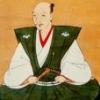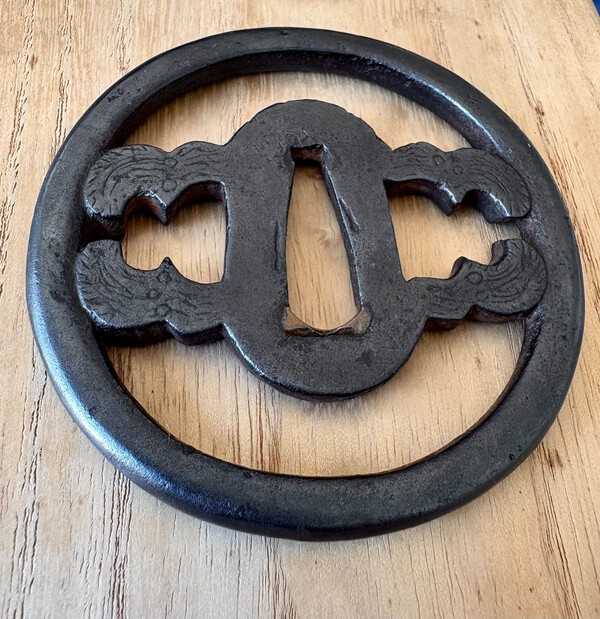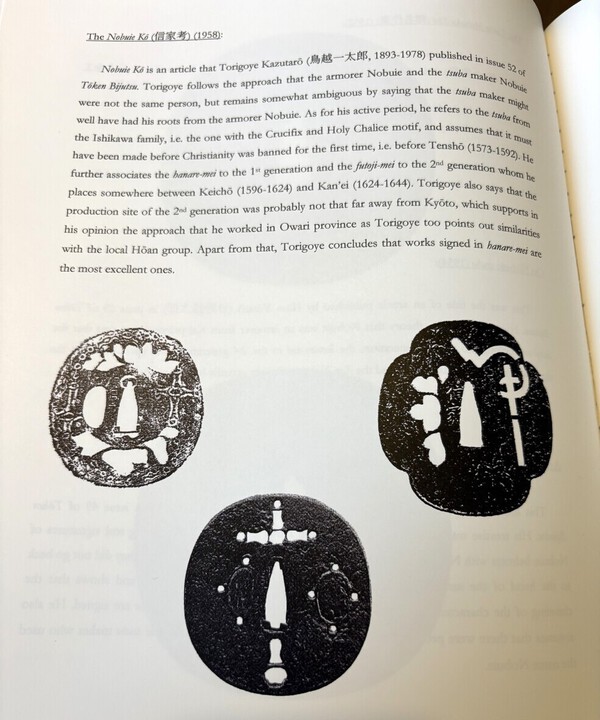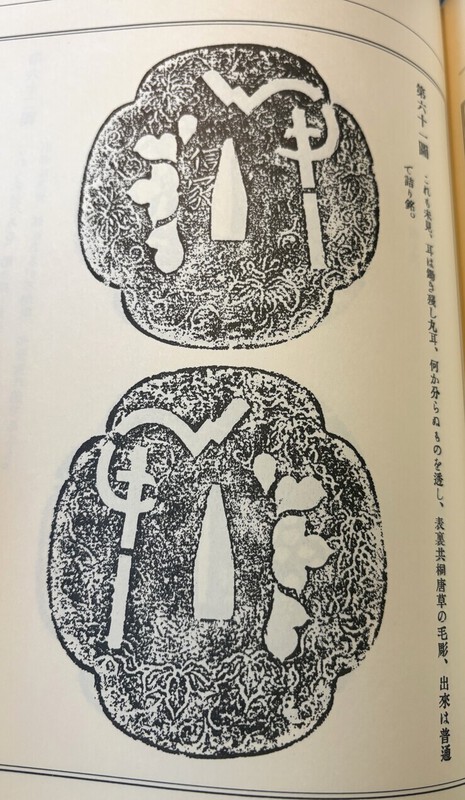-
Posts
962 -
Joined
-
Last visited
-
Days Won
4
Content Type
Profiles
Forums
Events
Store
Downloads
Gallery
Everything posted by Steve Waszak
-
Akasaka tsuba. Myoga (Japanese ginger) motif. Myoga was fairly often used in family crests, as it was believed to offer (divine) protection. Hence, it serves as an excellent subject in tsuba. This particular piece features powerful forms, both in the the rendering of the myoga elements and in the heavy rim, as well as in the boldly martial expression represented in the direct symmetry. The metal is beautiful: the clear grain, deep color, fine patina, and superb condition combine to create a gorgeous sword guard. The clean, uncluttered surface of the iron is relieved deftly via the fine carving of the details on the myoga elements. The seppa-dai is large and powerfully formed. The rim of the tsuba shows evidence of the forging, providing a subtle relief to the otherwise smoothly rounded contours. 76.5mm x 75.5mm x 6mm at the rim. $600 plus shipping.
-
Bravo, Manuel, bravo! Outstanding, both the work itself(!) and your result from the NBTHK. Extremely impressive.
-

Ohno Christian/Buddhist Tsuba (for whopping $112 on Jauce)
Steve Waszak replied to Iaido dude's topic in Tosogu
The literature on Nobuie tsuba as regards Christian motifs indicates (proves?) that such tsuba were made, and that the iconography was not hidden. Rather, it is more likely that we are simply not understanding the reference intended by the sukashi motif that has a strong floral suggestion. From Ito Mitsuru's book, Nobuie, we see three examples of early-Momoyama Nobuie tsuba with motifs identified as Christian (see below). And from Nobuie Tsuba ( which includes reproductions of Nobuie tsuba rubbings from Nakamura Kakudayu's Nobuie Tanshu), we see a specific sword guard noted, with the write-up (translated by Markus Sesko) recognizing the motif to be Christian (see images below referencing tsuba #61). Sometimes, it seems that there is a notion that all Christian iconography that tsubako may have employed must have been hidden, but during the time of Oda Nobunaga, especially, Christianity was practiced openly, and several prominent members of the Buke were known to be Christian. Given the elevated status of such men, and the standing of Nobuie as a tsubako, we can see that displays of Christian identity and/or association were hardly in need of being in the shadows. -

Can this tsuba have been made by fusing two iron plates?
Steve Waszak replied to Iaido dude's topic in Tosogu
Interesting discussion. Over the years, I have seen many tsuba with some degree of separation of folds, usually manifesting especially in the walls of the nakago-ana. I've seen it so much, in fact, that it seems to be a fairly ordinary occurrence, perhaps especially with older works (pre-Edo). In the pieces I've seen, though, the separating of the folds is frequently limited to a small area, such as one wall of the nagako-ana, and doesn't extend throughout the plate very far. Stephen's example here is one of the more extreme cases I think I've seen. -

Mumei Kanayama tsuba that point to a specific tsubako
Steve Waszak replied to Iaido dude's topic in Tosogu
Wow. Great tsuba. Fantastic pair of sword guards here. The iron in these pieces is just killer. Any reason this couldn't be first-generation Iesada? Congrats again, Curran. and nicely done. -

Mumei Kanayama tsuba that point to a specific tsubako
Steve Waszak replied to Iaido dude's topic in Tosogu
Superb tsuba, Curran. Many thanks for posting it. So great to see a Juyo-class Yamakichibei, and to see it well-photographed. Congratulations on this brilliant sword guard, my friend. And looking forward to seeing the Saotome, too. Which Saotome smith is it, if I may ask? -

Ohno Christian/Buddhist Tsuba (for whopping $112 on Jauce)
Steve Waszak replied to Iaido dude's topic in Tosogu
Hi Stephen, Sorry to see that this tsuba is cast. This threat is always out there now. I suppose this fact brings the silver lining that it encourages us to be constantly vigilant, not only for signs of a piece being cast, but also for other signs that the item isn't quite what it may seem to be. I did like your write-up, anyway! As for the design being tied to Yagyu and Ohno guards, it is understood that the Ohno tsubako did make some tsuba for the Yagyu (most, if not all Yagyu tsuba were actually made by Owari smiths of the time, such as Fukui, Toda, and Sakura Yamakichibei. Among these, though, too, were Ohno smiths). So, it doesn't surprise me that we would see some overlap in designs between guards designated as Yagyu, and those attributed to Ohno. -
Just wanted to chime in here to say that I am really enjoying this topic and thread, and very much appreciate all of the excellent observations, insights, and viewpoints.
-
Excellent acquisition, Okan. Very powerful design. Congratulations. Would love to see this in person some day.
-
It is with much sadness that I have to present the news here that the long-time tsuba scholar and historian, Bruce Kirkpatrick, has passed away (this past Monday). Many here may not have known, or known of Bruce, as he did not participate in online forums. However, he was a major figure in tosogu scholarship, particularly tsuba, having been involved in studying, researching, and collecting Japanese sword guards for over fifty years. Unfortunately, Bruce was quite reluctant to publish his findings and insights, and, despite my frequent encouragement, he could never be persuaded to put his thoughts into writing. This is a great loss for all of us who are serious in our pursuit of tosogu study and learning. In the twenty-plus years I have been deeply involved in the scholarship, connoisseurship, and collecting of tsuba, I have never encountered another with the degree and breadth of insight Bruce had in this field. His ability and capacity to identify and put together seemingly disparate pieces of information from the most widely scattered sources, and to do so convincingly, was nothing short of astonishing. Ever the iconoclast, his views not infrequently challenged the status-quo traditional understandings of many aspects of tsuba, including those pertaining to schools, construction methods, influences on design, and many other aspects. He was often forceful and unapologetic about issuing these challenges; for some, his manner was too churlish, harsh, and disrespectful of tradition, and so, there were those who chose not to associate with Bruce. While I understand such sentiments (and felt some of these myself), the brilliant insights he had on so many topics in the world of tsuba ultimately more than made up for his thorny nature. I can say emphatically here that I have learned more from Bruce about tsuba and the cultural milieu that informed so much about them than I have from all other sources combined. Historian, aesthete, cultural critic par excellence, Bruce will be sorely missed by those of us who had the opportunity to know him well. RIP Bruce
-
Hi David, Not surprised that the two Yamakichibei works you acquired from me in 2017 would come back gimei if submitted to shinsa. That is a predictable result, given the NBTHK's flawed perspective on Yamakichibei, as Glen and I have been referencing here. These two would have been daisaku/daimei works -- still a part of the late-Yamakichibei atelier in the early Edo Period, but not made by the master Low-Crossbar smith himself. Essentially, the Low-Crossbar Yamakichibei that have the best chance of passing shinsa will be pieces the master made himself, especially if these are larger works (as in the example I post above [which is unpapered, however, as I don't submit works to shinsa, for various reasons]). Tsuba with the Low-Crossbar mei that are smaller -- 68-72mm -- and which are more rote in their designs and workmanship, will rarely pass shinsa. Again, this is predictable (though the second example below, is an exception of sorts. It is larger than most daisaku/daimei works). Here is a link to a couple of Low-Crossbar Yamakichibei tsuba that have been papered. The first is certainly a piece by the master, a very strong, large, expressive form, appearing in the fourth row of tsuba presented in the "Tsuba Sale" section of this website: http://www.jp-sword.com/ This second one (see Row 8 of the Tsuba Sale section of the above website) is likely a daisaku/daimei piece. Note the relative lack of dynamism and vitality in this tsuba when compared with the example above, and when compareed with the large mokko guard I posted an image of in an earlier post. The difference in expressive power is notable. This is the rare exception where what (I am confident) is a daisaku/daimei work does pass shinsa and is papered. *While both of these examples here are described in the captions of the site on which they appear as "shodai" works, this, again, is in error. Please refer to my earlier posts above on this point.
-
Well, this piece is relatively bland, lacking the dynamism and sensitivity in aesthetic expression seen in genuine works. It presents as rather stiff, and the mei details do not conform to those of any of the true early smiths. So, this being gimei is a judgment I would agree with, and a determination that is easy to make. It's not a bad tsuba as tsuba go; it's just not a genuine Yamakichibei work.
-
Good post, Glen. Thanks for this. Yes, the Low-Crossbar smith was undoubtedly part of the early group of Yamakichibei smiths, well predating the Sakura Yamakichibei smith by as much as half a century. The daisaku/daimei phenomenon associated with the Low-Crossbar smith, though, clearly (to me) locates him later in the Momoyama Period to earliest-Edo period. These daisaku/daimei guards carry a definite Low-Crossbar mei, which differs sharply in many ways from that of Yamasaka Kichibei or of the Meijin-Shodai. This daisaiku/daimei phenomenon is culturally and temporally consistent with social evolutions in craft "factories" that emerged and grew after the dawn of the 17th century. The huge quantity and relatively low(er) quality of these Low-Crossbar-signed daisaku/daimei works is in keeping with the kind of production we would expect to see out of a higher-volume/output "factory" context. Since there are FAR more of these Low-Crossbar daisaku/daimei tsuba extant than all other Yamakichibei sword guards combined, we cannot logically locate their production time to the beginning of the Yamakichibei atelier. The actual Low-Crossbar master's workmanship is much superior to what we see in even the best daisaku/daimei tsuba, but the Low-Crossbar smith's guards are notably distinct from either the Meijin-Shodai's or Yamasaka Kichibei's. The difference between Low-Crossbar work and that of the Meijin-Shodai, in particular, is rather stark. Low-Crossbar work is often more overtly dramatic and bold, featuring plate work (tsuchime and finishing) that is significantly more pronounced than the Meijin-Shodai's, whose plates are usually relatively quiet and reserved (for a Yamakichibei work, that is). See images below. The large mokko tsuba is a Low-Crossbar piece; the other two (with the long-eared rabbits or dragonflies motif, and then with the suhama motif, respectively) feature plates whose expression is more subdued, but still resonant with strength, of course. As for the actual Shodai, this would undoubtedly be Yamasaka Kichibei. There can be no logical dissent here. It simply would not be done -- and would not even be conceivable, culturally, really -- for a later Yamakichibei smith to be audacious enough to ADD another character to the already-established Yamakichibei art name, when that art name had been decided by a different (would-be founding) smith. Moreover, the workmanship and design choices seen in Yamasaka works and then in works by the Meijin-Shodai show a clear and strong relationship between them, much more so than in any would-be relationship between Yamasaka and the Low-Crossbar master. The frequent use of kuruma-sukashi designs, additionally, locates them as contemporaneous with the Nobuiye smiths and with Kawaguchi Hoan, as all four of these smiths -- working in Kiyosu in Owari Province -- would have been in "design dialogue" with one another, as, in keeping with Japanese traditions, craftsmen in the same field often lived in the same neighborhood. Meanwhile, of the many Low-Crossbar pieces I've seen, there have been no kuruma-sukashi works, even by the daisaku/daimei workers. Evidently, that vogue had passed by the time of the Low-Crossbar smith. Even the Nidai Yamakichibei was scarcely making such kuruma-sukashi pieces: I have seen only one such piece by him in all the time I've been focused on this group. While none of the above may amount to "hard factual evidence," and may indeed be "only" a theory, I honestly do not see any other theory that does have merit. The Low-Crossbar-smith-as-Shodai theory does not have any merit, in my view. The evidence for it is so weak that it does not stand up to even the most casual scrutiny. This said, it is clear, as I stated to begin with (and echoing you, Glen), that the Low-Crossbar smith is indeed a part of the early Yamakichibei atelier, and that works by him are not "gimei" as the Shinsa results would have it. I am amused, actually, by the dynamic that explains why Low-Crossbar works may be papered (implicitly) as Shodai: the work is so good that it simply cannot be fake, yet the signature differs radically from that of the Meijin-Shodai. Rather than recognizing the obvious (the original understanding of the Yamakichibei group is wrong), they instead contrive the notion that the Meijin-Shodai changed his signature in all these different ways. Such "understandings" do a great disservice to tsuba scholarship. Low-Crossbar Yamakichibei. Mokkogata. Bird-and-kama motif. Meijin-Shodai Yamakichibei. Nagamarugata. Long-eared rabbit or dragonfly motif. Meijin-Shodai Yamakichibei. Mutsu Mokkogata. Suhama motif.
-
Hi Grev, Your question is a good one, and a bit more complicated than it might appear. The short answer to your question is yes, Yamakichibei tsuba with a Low-Crossbar mei have indeed passed shinsa; in fact, one of the 11 or 12 Juyo Yamakichibei guards features a Low-Crossbar mei. I know of several others with this mei that are papered as well. Here's the catch, though: tsuba with this mei that have passed shinsa are papered as though they are Shodai work. The truth, however, is that they are not, as close analytical comparison of Low-Crossbar-signed guards with actual (Meijin-) Shodai guards will clearly show, both in the workmanship of the tsuba themselves, and in the rendering of the respective signatures. The rationale for papering Low-Crossbar Yamakichibei works as (Meijin-) Shodai works is explained as follows: "Changes in the way that the Shodai inscribed his signatures are recognized and accepted." This is nonsense, I'm afraid. As I say, the actual workmanship of the tsuba made by the Meijin-Shodai Yamakichibei differs significantly from that seen in the works produced by the Low-Crossbar smith. Beyond this, though, the Low-Crossbar signature is radically different from the Meijin-Shodai's. Every part of the signature, from the "Yama" ji to the "Kichi" ji to the "Bei" ji is not only dramatically different, but the differences are consistent in the works of the two. Moreover, there are no sword guards that I have seen (and I have been studying this subject for more than twenty years) that could remotely be identified or described as having a "hybrid mei" -- one that has elements in the mei drawn from a typical Meijin-Shodai tsuba and also elements drawn from a standard Low-Crossbar work. It is abundantly evident that the Shinsa teams are either genuinely erring in their papering of Low-Crossbar works as (Meijin-) Shodai works, or are motivated by some other factor. For a far more detailed analysis of this subject, see the article I did on the Yamakichibei group of tsubako, available in the Articles section here on NMB. Hope this helps, Grev.
-

(Higo) Hayashi Plum Tree Tsuba $595 FOR SALE .
Steve Waszak replied to Curran's topic in Sold Archive
Excellent tsuba. Even better price. If I collected Higo, this would be gone. -

Assistance with description of motif element
Steve Waszak replied to Steve Waszak's topic in Translation Assistance
Great observation, Tim. I had seen the elements as chrysanthemums, too, but had not linked it to Kusunoki. Many thanks for that! I do wonder how these kiku are fitted into the larger sukashi element, though. What does the whole of this sukashi element -- kiku included -- mean? And since we see the same element in your tsuba here, what are the semantics in association with the respective sukashi elements opposite this kiku sukashi form? Good stuff, Tim. Thanks again. Piers, thanks for your thoughts, too! But IS that a broken water wheel? I have my doubts. The end elements of the "wheel" seem oddly truncated, if it's supposed to depict a broken wheen. I'm reminded more of something like a segmented arthropod.














